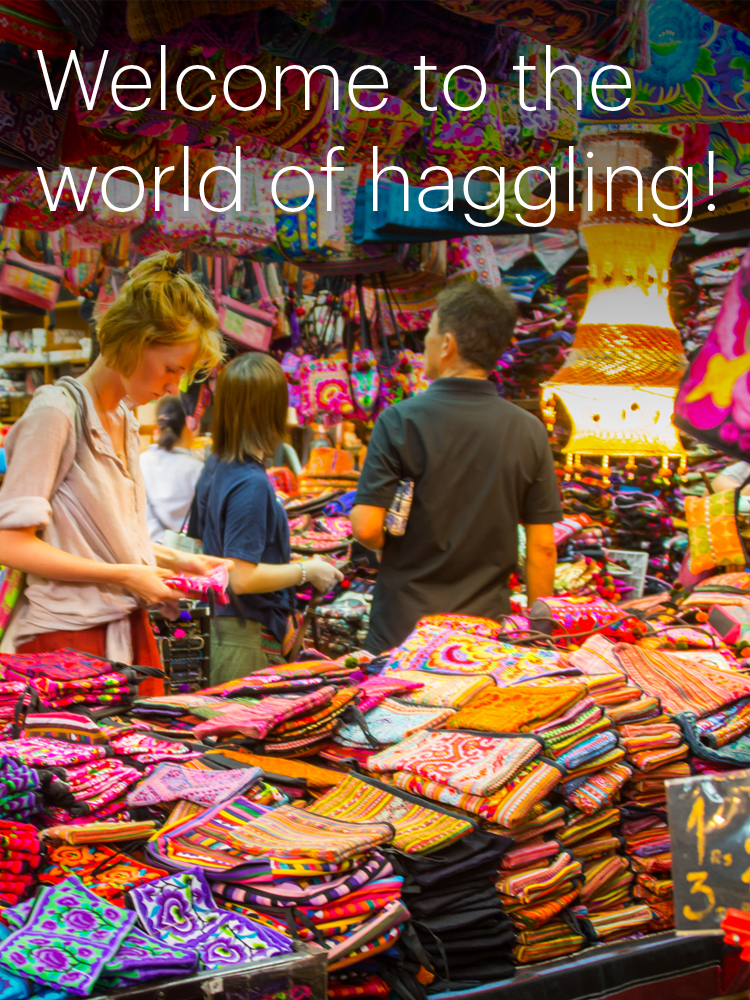Visiting the Asia Pacific? Welcome to the world of haggling! (Part One)
Haggling! Love it? Hate it?
Haggling is a way of life in much of Asia. It’s a significant cultural difference from North America and most of Europe, a mindset that baffles the most confident Western visitor. Whether it’s called haggling or negotiating, the practice is widespread in markets throughout Asia.
North Americans and many Europeans, coming from environments where the person transacting business does not have the power to haggle, find the whole process a waste of time. According to Wendi Adair of the University of Waterloo, who specializes in negotiation in the global marketplace, Americans are less likely to negotiate by using offers, which form the basis for haggling. Americans, she says, ask questions and make statements: “What a great TV! It’s very expensive, though. Will it likely be on sale at all this fall? “Wow, $800? That’s way more than at Best Buy…”). But they won’t just walk in and place an offer on the table. (“$800? I’ll give you $550.”)
The Western approach doesn’t involve making offers or seeking counteroffers, the back and forth process of haggling; it’s based on an appreciation for accounting, finance, and predictability. However, not understanding this cultural difference can alter your whole experience in the APAC region, so that’s why we’re going to talk about haggling in two parts: the first this month is your experience as a visitor and the second will be your business experience.
Right off, we want to remind you that at Idea International, we encourage you to experience the local scene while we take care of your exhibiting needs, aka “Peace of Mind.” That being the case, we offer these tips on haggling so you can enjoy your time in one of our incredible cities.
For Westerners, haggling is often hard to handle. When you visit Asia, haggling is not only accepted but expected; it’s the way deals get made, and people make a living. There are some steps you can take to prepare yourself to experience and enjoy the process.
- Try to use some of the local languages. Merchants appreciate the effort.
- Take your time. You are probably so used to walking to the counter with your purchase and credit card, then making a quick exit–never mind the increasingly common cashless store experience–that you need to adjust. Relax, smile, be patient—and be polite.
- Even if you are interested, act as if you are not. A staged walk away often helps get an excellent price.
- Start bargaining at half the price of whatever the merchant tells you. That gives you a lot of flexibility.
- If the merchant insists that they are quoting the lowest price possible, ask for some extras or suggest you can buy more than one of the item.
- Ask locals (or your Idea International crew!) what you should expect to pay, especially in the case of taxis or tuk-tuks.
- Remember, Western ways are creeping in; you can’t haggle for everything. Established retail stores usually have fixed prices.
- Don’t get angry. The merchant is trying to make a living.
- Don’t give in too early. You’re not offending anyone by not accepting the first price. At its best, haggling makes both parties happy.
- Determine what you want, what you are willing to pay, and what you will walk away from.
- Understand the seller. If they are artists or craftspersons, show appreciation for the item’s sentimental value. Appreciation usually leads to a good price.
- There will be some back and forth. Remember that it is the merchant’s job to say no, and it is yours to get them to say yes.
- Ask all the questions you need to ask before you start haggling. In other words, do some fact-finding and decide that you want the item. Only after you have asked all your questions should you begin to haggle.
- Never try to defend your price, as in “I can get this cheaper in the U.S.” Defensiveness is a sign of weakness and shows you are a rookie haggler.
- Remember, silence is the most persuasive tactic. Name your price, say nothing, and say nothing until you get your price.
Now you can return to the event venue and find your exhibit completed and show-ready. You will also have some wonderful stories to share with us. Exhibiting in the APAC region is not only necessary to expand to global markets (more on that in the next newsletter), but it can be fun!
We’re here to help! Contact us now.




Comments are closed.